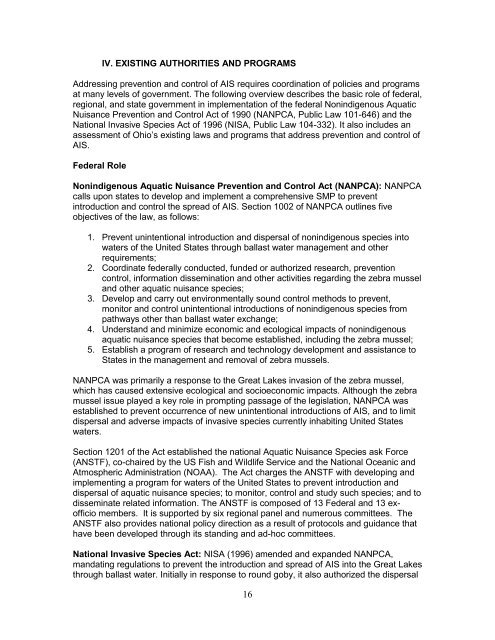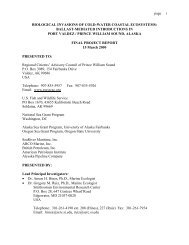State Management Plan for Aquatic Invasive Species Ohio ...
State Management Plan for Aquatic Invasive Species Ohio ...
State Management Plan for Aquatic Invasive Species Ohio ...
You also want an ePaper? Increase the reach of your titles
YUMPU automatically turns print PDFs into web optimized ePapers that Google loves.
IV. EXISTING AUTHORITIES AND PROGRAMS<br />
Addressing prevention and control of AIS requires coordination of policies and programs<br />
at many levels of government. The following overview describes the basic role of federal,<br />
regional, and state government in implementation of the federal Nonindigenous <strong>Aquatic</strong><br />
Nuisance Prevention and Control Act of 1990 (NANPCA, Public Law 101-646) and the<br />
National <strong>Invasive</strong> <strong>Species</strong> Act of 1996 (NISA, Public Law 104-332). It also includes an<br />
assessment of <strong>Ohio</strong>’s existing laws and programs that address prevention and control of<br />
AIS.<br />
Federal Role<br />
Nonindigenous <strong>Aquatic</strong> Nuisance Prevention and Control Act (NANPCA): NANPCA<br />
calls upon states to develop and implement a comprehensive SMP to prevent<br />
introduction and control the spread of AIS. Section 1002 of NANPCA outlines five<br />
objectives of the law, as follows:<br />
1. Prevent unintentional introduction and dispersal of nonindigenous species into<br />
waters of the United <strong>State</strong>s through ballast water management and other<br />
requirements;<br />
2. Coordinate federally conducted, funded or authorized research, prevention<br />
control, in<strong>for</strong>mation dissemination and other activities regarding the zebra mussel<br />
and other aquatic nuisance species;<br />
3. Develop and carry out environmentally sound control methods to prevent,<br />
monitor and control unintentional introductions of nonindigenous species from<br />
pathways other than ballast water exchange;<br />
4. Understand and minimize economic and ecological impacts of nonindigenous<br />
aquatic nuisance species that become established, including the zebra mussel;<br />
5. Establish a program of research and technology development and assistance to<br />
<strong>State</strong>s in the management and removal of zebra mussels.<br />
NANPCA was primarily a response to the Great Lakes invasion of the zebra mussel,<br />
which has caused extensive ecological and socioeconomic impacts. Although the zebra<br />
mussel issue played a key role in prompting passage of the legislation, NANPCA was<br />
established to prevent occurrence of new unintentional introductions of AIS, and to limit<br />
dispersal and adverse impacts of invasive species currently inhabiting United <strong>State</strong>s<br />
waters.<br />
Section 1201 of the Act established the national <strong>Aquatic</strong> Nuisance <strong>Species</strong> ask Force<br />
(ANSTF), co-chaired by the US Fish and Wildlife Service and the National Oceanic and<br />
Atmospheric Administration (NOAA). The Act charges the ANSTF with developing and<br />
implementing a program <strong>for</strong> waters of the United <strong>State</strong>s to prevent introduction and<br />
dispersal of aquatic nuisance species; to monitor, control and study such species; and to<br />
disseminate related in<strong>for</strong>mation. The ANSTF is composed of 13 Federal and 13 exofficio<br />
members. It is supported by six regional panel and numerous committees. The<br />
ANSTF also provides national policy direction as a result of protocols and guidance that<br />
have been developed through its standing and ad-hoc committees.<br />
National <strong>Invasive</strong> <strong>Species</strong> Act: NISA (1996) amended and expanded NANPCA,<br />
mandating regulations to prevent the introduction and spread of AIS into the Great Lakes<br />
through ballast water. Initially in response to round goby, it also authorized the dispersal<br />
16














